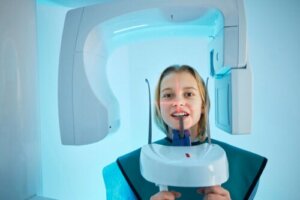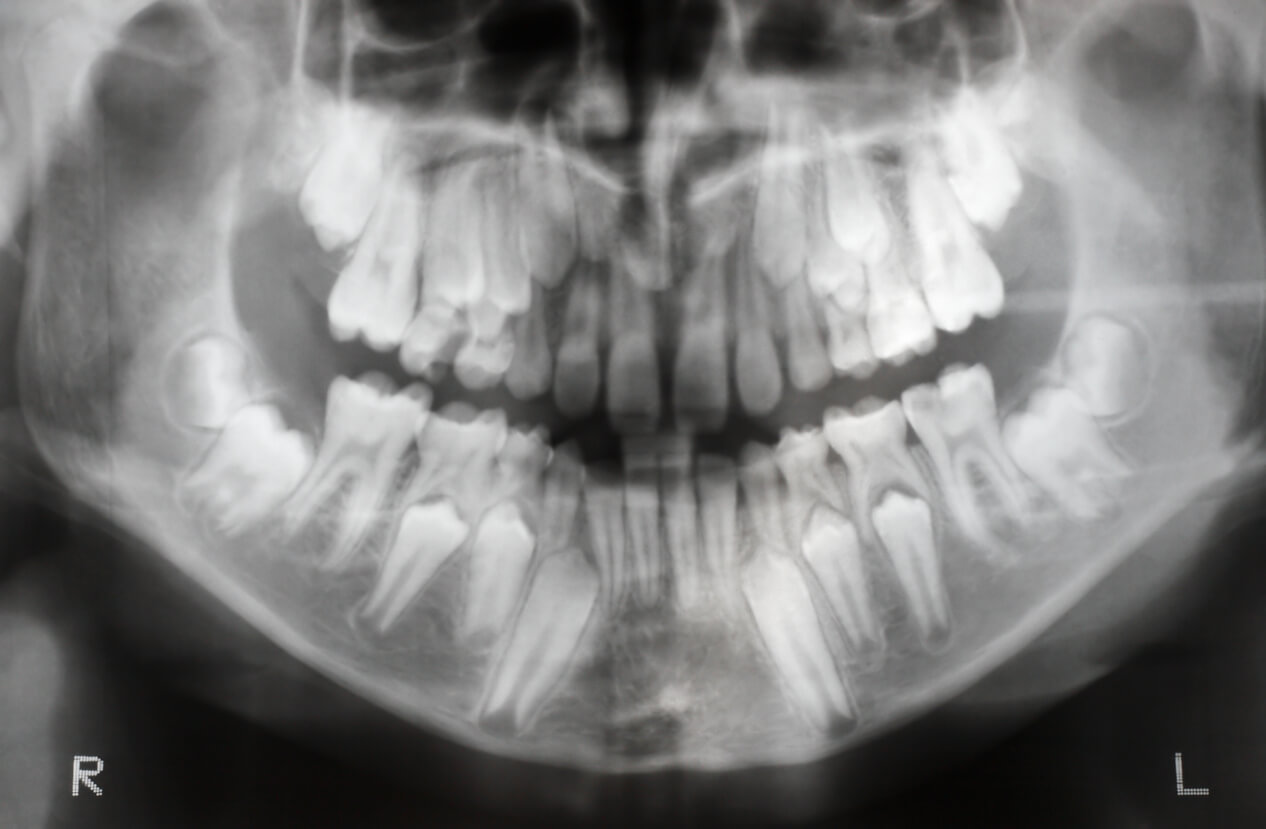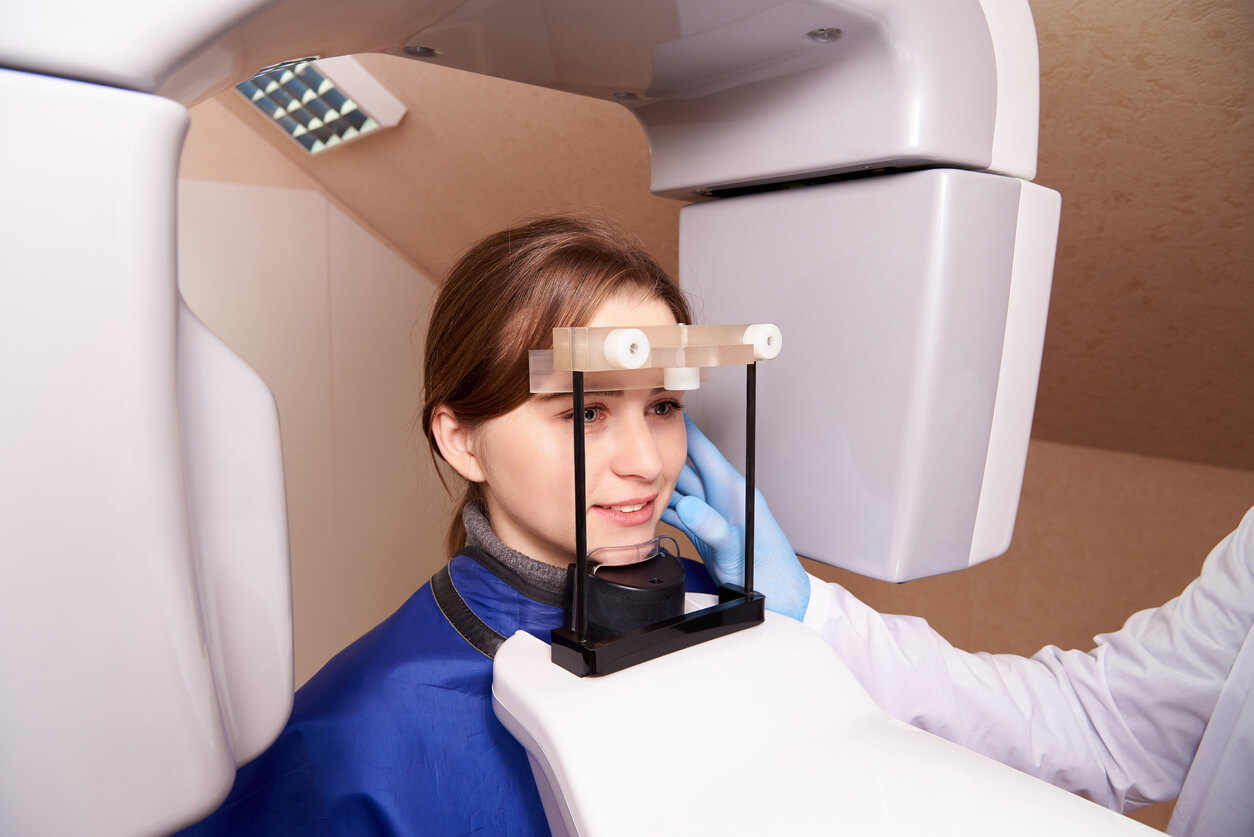Dental X-Rays in Children: When Are They Necessary?


Written and verified by the dentist Vanesa Evangelina Buffa
In the dental care of children, it’s often necessary to resort to dental X-rays to arrive at a diagnosis or to carry out a treatment. This complementary procedure provides useful information that otherwise would be unknown. In this way, detailed images of the internal structures of the oral cavity are obtained by using X-radiation.
It’s common for some parents to feel fear or concern if their children need dental X-rays. Therefore, in this article, we’ll clarify everything you should know about this procedure in children.
What are dental X-rays in children?
Dental X-rays are images of the teeth and other oral structures obtained through X-rays. This type of radiation penetrates and passes through the body to form an image on a screen or film. X-rays are absorbed to a greater or lesser extent by the various tissues of the body. Therefore, more or less radiation arrives, and this is what will determine the color of each image on the developed film.
Hard tissues, such as dental enamel, bone, and metal fillings, are dense and block much of the radiation. For this reason, they’re displayed in white. On the other hand, soft structures, with high organic content, allow the rays to pass through and appear darker and grayish in color.
There are different techniques for taking dental X-rays in children, although they can be grouped into two main categories:
- Intraoral: The radiographic film is placed inside the child’s oral cavity.
- Extraoral: The film goes outside the mouth.
When are dental X-rays necessary in children?
Dental X-rays in children are useful to facilitate and confirm certain diagnoses and to plan certain treatments. In this way, it’s possible to detect problems that aren’t visible to the naked eye. Pediatric dentists may indicate them in the following situations:
- Interproximal or deep cavities: With radiographs, their presence is confirmed and their extension is visualized.
- To detect filtered or poorly adapted arrangements.
- To diagnose lesions inside the bone or mucous membranes such as abscesses, cysts, and tumors.
- Dental fractures and trauma: Radiographic images allow the observation of the type and severity of the injury and the affected tissues.
- Bone loss.
- Developmental abnormalities.
- Retained teeth or impacted teeth in the interior of the bone that haven’t yet erupted.
- Missing or extra teeth.

Dental X-rays in children as part of treatment
Dental X-rays in children are also used as a preliminary step to certain treatments. These types of studies are essential before surgery or endodontics.
They are also especially important before orthodontic treatment is started. In fact, according to a study on the frequency of dental X-rays in children and adolescents, approximately one-third of all extraoral exposures are for orthodontic indications.
When are they performed?
In children at high risk of cavities, the professional may order X-rays once or twice a year to detect new lesions and monitor the treatments performed. On the other hand, in those with less possibility of contracting the disease, X-rays can be done less frequently.
At the same time, at six years of age, the first evaluation with an orthodontist is recommended. The specialist may order dental x-rays if they suspect a bite problem. In addition, they’ll be necessary if your child suffers a blow to the mouth. This is because the images inside the mouth can detect injuries to the bone, tooth roots, or tissues.
Types of dental X-rays in children
There are different types of dental X-rays used in children. The choice of the procedure and technique to be used depends on the tissues the practitioner wishes to observe.
Intraoral X-rays
Intraoral dental X-rays are those taken by placing the plate inside the mouth. In general, the patient themself or their parents hold the film during the study. These techniques are performed in the traditional way with a minimum amount of radiation. There are also digital methods that allow the images to be obtained on a computer and use less radiation.
Among the intraoral dental radiographs used in children, the following types can be distinguished:
- Periapical: This is a small image that allows the entirety of one or two dental elements to be observed. The complete crown, the root of the tooth element, and the surrounding tissues are seen in detail.
- Interproximal or bitewing X-rays: A complete image of the upper and lower dental crowns is obtained at the same time. To perform it, the patient must bite down on a small bitewing attached to the radiographic film. They’re useful for the diagnosis of proximal caries.
- Occlusal: A larger plate than the previous ones is used. It’s placed between the upper and lower arches and the patient is made to bite on it. This allows the capturing of the position of the dental pieces and the observation of impacted teeth.

Extraoral dental X-rays in children
Another type of dental X-ray used in children is extraoral X-ray. In these procedures, the radiographic film is placed outside the patient’s mouth. The following are the most commonly used:
- Orthopantomography or “panoramic radiography”: Allows the entire mouth to be observed in a single shot. With minimal exposure and a simple and comfortable procedure, it provides a large amount of useful data.
- Teleradiography, cephalometry, or “lateral skull radiograph”: This is a study that’s performed before starting orthodontic treatment. It shows a profile view of the face and allows the exact relationship between the jaws to be observed.
Are dental X-rays safe for children?
There’s a general fear surrounding dental X-rays in children. However, the doses used for this type of study are very low and the technology is safe for children. In addition, additional safety measures are employed, such as placing lead vests on the body and lead collars around the neck. In this way, the reproductive organs and the thyroid gland are protected.
What you should consider is that the radiation received by our body accumulates in the tissues. Even if the doses are low, they remain in the body and can cause long-term effects. However, with new technologies, this risk is minimal. For this reason, dental X-rays in children are only performed when strictly necessary and when their use is justified.
Trust your pediatric dentist
Dental X-rays are useful for diagnosis and some dental treatments in children. They allow early detection and treatment of certain problems that, if left untreated, can progress, worsen, and cause serious consequences. The doses of radiation used are minimal and don’t pose a health risk. In addition, it’s a simple and comfortable study for the child.
In any case, their use is limited to cases in which they’re really necessary. You should trust the pediatric dentist’s judgment and know that, if they recommend this study, it’s because it’s what’s best for your child.
In the dental care of children, it’s often necessary to resort to dental X-rays to arrive at a diagnosis or to carry out a treatment. This complementary procedure provides useful information that otherwise would be unknown. In this way, detailed images of the internal structures of the oral cavity are obtained by using X-radiation.
It’s common for some parents to feel fear or concern if their children need dental X-rays. Therefore, in this article, we’ll clarify everything you should know about this procedure in children.
What are dental X-rays in children?
Dental X-rays are images of the teeth and other oral structures obtained through X-rays. This type of radiation penetrates and passes through the body to form an image on a screen or film. X-rays are absorbed to a greater or lesser extent by the various tissues of the body. Therefore, more or less radiation arrives, and this is what will determine the color of each image on the developed film.
Hard tissues, such as dental enamel, bone, and metal fillings, are dense and block much of the radiation. For this reason, they’re displayed in white. On the other hand, soft structures, with high organic content, allow the rays to pass through and appear darker and grayish in color.
There are different techniques for taking dental X-rays in children, although they can be grouped into two main categories:
- Intraoral: The radiographic film is placed inside the child’s oral cavity.
- Extraoral: The film goes outside the mouth.
When are dental X-rays necessary in children?
Dental X-rays in children are useful to facilitate and confirm certain diagnoses and to plan certain treatments. In this way, it’s possible to detect problems that aren’t visible to the naked eye. Pediatric dentists may indicate them in the following situations:
- Interproximal or deep cavities: With radiographs, their presence is confirmed and their extension is visualized.
- To detect filtered or poorly adapted arrangements.
- To diagnose lesions inside the bone or mucous membranes such as abscesses, cysts, and tumors.
- Dental fractures and trauma: Radiographic images allow the observation of the type and severity of the injury and the affected tissues.
- Bone loss.
- Developmental abnormalities.
- Retained teeth or impacted teeth in the interior of the bone that haven’t yet erupted.
- Missing or extra teeth.

Dental X-rays in children as part of treatment
Dental X-rays in children are also used as a preliminary step to certain treatments. These types of studies are essential before surgery or endodontics.
They are also especially important before orthodontic treatment is started. In fact, according to a study on the frequency of dental X-rays in children and adolescents, approximately one-third of all extraoral exposures are for orthodontic indications.
When are they performed?
In children at high risk of cavities, the professional may order X-rays once or twice a year to detect new lesions and monitor the treatments performed. On the other hand, in those with less possibility of contracting the disease, X-rays can be done less frequently.
At the same time, at six years of age, the first evaluation with an orthodontist is recommended. The specialist may order dental x-rays if they suspect a bite problem. In addition, they’ll be necessary if your child suffers a blow to the mouth. This is because the images inside the mouth can detect injuries to the bone, tooth roots, or tissues.
Types of dental X-rays in children
There are different types of dental X-rays used in children. The choice of the procedure and technique to be used depends on the tissues the practitioner wishes to observe.
Intraoral X-rays
Intraoral dental X-rays are those taken by placing the plate inside the mouth. In general, the patient themself or their parents hold the film during the study. These techniques are performed in the traditional way with a minimum amount of radiation. There are also digital methods that allow the images to be obtained on a computer and use less radiation.
Among the intraoral dental radiographs used in children, the following types can be distinguished:
- Periapical: This is a small image that allows the entirety of one or two dental elements to be observed. The complete crown, the root of the tooth element, and the surrounding tissues are seen in detail.
- Interproximal or bitewing X-rays: A complete image of the upper and lower dental crowns is obtained at the same time. To perform it, the patient must bite down on a small bitewing attached to the radiographic film. They’re useful for the diagnosis of proximal caries.
- Occlusal: A larger plate than the previous ones is used. It’s placed between the upper and lower arches and the patient is made to bite on it. This allows the capturing of the position of the dental pieces and the observation of impacted teeth.

Extraoral dental X-rays in children
Another type of dental X-ray used in children is extraoral X-ray. In these procedures, the radiographic film is placed outside the patient’s mouth. The following are the most commonly used:
- Orthopantomography or “panoramic radiography”: Allows the entire mouth to be observed in a single shot. With minimal exposure and a simple and comfortable procedure, it provides a large amount of useful data.
- Teleradiography, cephalometry, or “lateral skull radiograph”: This is a study that’s performed before starting orthodontic treatment. It shows a profile view of the face and allows the exact relationship between the jaws to be observed.
Are dental X-rays safe for children?
There’s a general fear surrounding dental X-rays in children. However, the doses used for this type of study are very low and the technology is safe for children. In addition, additional safety measures are employed, such as placing lead vests on the body and lead collars around the neck. In this way, the reproductive organs and the thyroid gland are protected.
What you should consider is that the radiation received by our body accumulates in the tissues. Even if the doses are low, they remain in the body and can cause long-term effects. However, with new technologies, this risk is minimal. For this reason, dental X-rays in children are only performed when strictly necessary and when their use is justified.
Trust your pediatric dentist
Dental X-rays are useful for diagnosis and some dental treatments in children. They allow early detection and treatment of certain problems that, if left untreated, can progress, worsen, and cause serious consequences. The doses of radiation used are minimal and don’t pose a health risk. In addition, it’s a simple and comfortable study for the child.
In any case, their use is limited to cases in which they’re really necessary. You should trust the pediatric dentist’s judgment and know that, if they recommend this study, it’s because it’s what’s best for your child.
All cited sources were thoroughly reviewed by our team to ensure their quality, reliability, currency, and validity. The bibliography of this article was considered reliable and of academic or scientific accuracy.
- Aps, J. K. M., Lim, L. Z., Tong, H. J., Kalia, B., & Chou, A. M. (2020). Diagnostic efficacy of and indications for intraoral radiographs in pediatric dentistry: a systematic review. European Archives of Paediatric Dentistry, 21, 429-462.
- Arzani, V., & Bagherzadeh, A. (2021). Parental Knowledge Regarding Dental Radiography of Children Attending Dental Clinics in Ilam, Iran. Avicenna Journal of Dental Research, 13(3), 76-80.
- Barba Ramírez, L., Ruiz García de Chacón, V., & Hidalgo Rivas, A. (2020). El uso de rayos X en odontología y la importancia de la justificación de exámenes radiográficos. Avances en Odontoestomatología, 36(3), 131-142.
- Hennig, C. L., Schüler, I. M., Scherbaum, R., Buschek, R., Scheithauer, M., Jacobs, C., & Mentzel, H. J. (2023). Frequency of Dental X-ray Diagnostics in Children and Adolescents: What Is the Radiation Exposure?. Diagnostics, 13(3), 394.
- Kose, T. E., Gunacar, D. N., Arslan, I., & Peker, K. (2022). Factors affecting the parental knowledge, beliefs, and attitudes towards pediatric dental X-rays. Clinical Oral Investigations, 26(11), 6539-6549.
- Kühnisch, J., Anttonen, V., Duggal, M. S., Spyridonos, M. L., Rajasekharan, S., Sobczak, M., … & Tsiklakis, K. (2020). Best clinical practice guidance for prescribing dental radiographs in children and adolescents: an EAPD policy document. European Archives of Paediatric Dentistry, 21, 375-386.
- Mohanty, S., & Panigrahi, A. (2019). Dental Radiography in Pediatric Dentistry: A Review. Indian Journal of Public Health Research & Development, 10(11).
- Wilches-Visbal, J. H., Castillo Pedraza, M. C., & Jamil Khoury, H. (2021). Protección Radiológica en Radiología Dental. CES Odontología, 34(1), 52-67.
This text is provided for informational purposes only and does not replace consultation with a professional. If in doubt, consult your specialist.








